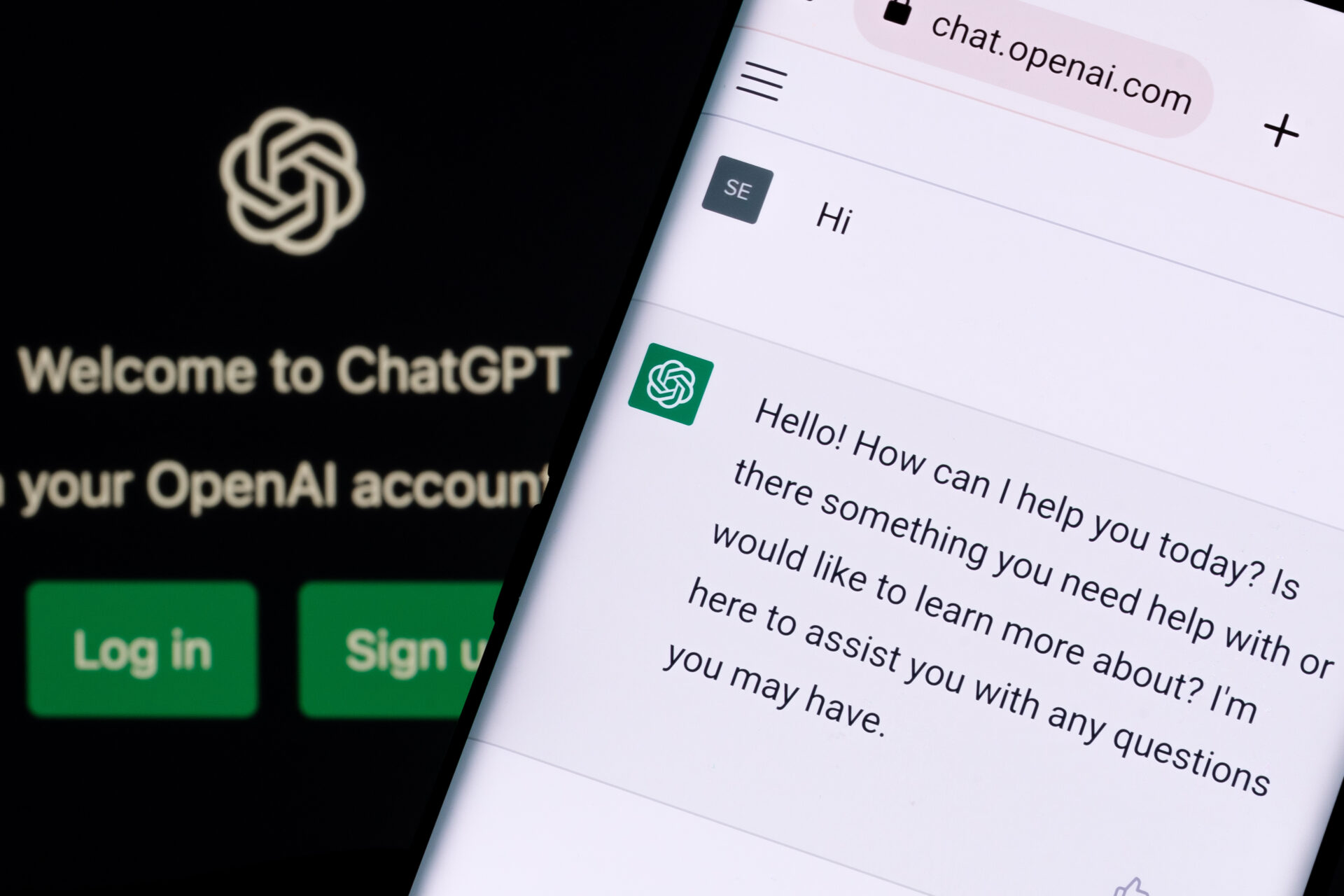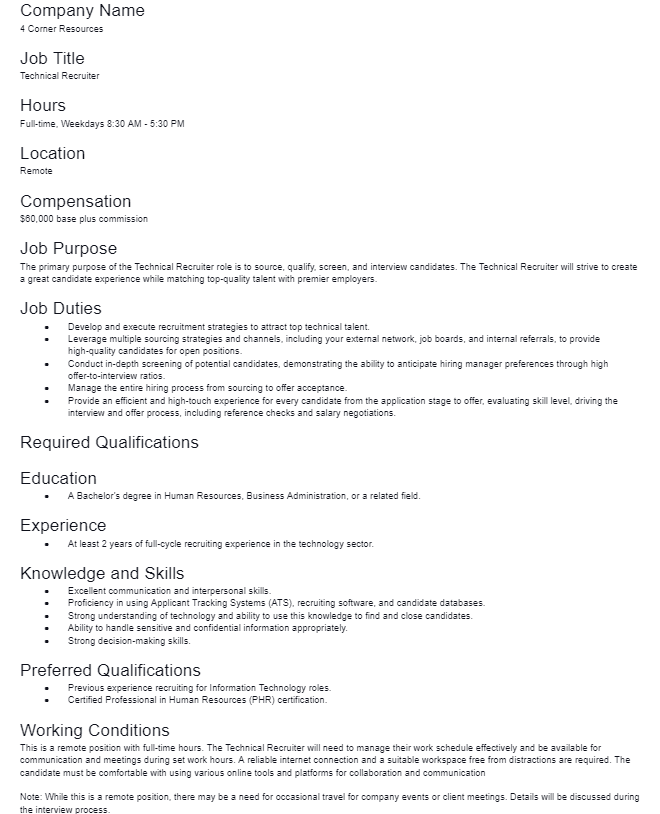How to Create a Job Description with ChatGPT

In the world of talent acquisition and recruitment, a comprehensive and compelling job description is a critical tool. Not only does it define the expectations of a role, but it also serves as the first touchpoint between a company and potential candidates. Therefore, job descriptions must be well-crafted, clear, and informative.
In two decades as a staffing company owner, I’ve come to learn two indisputable job description facts:
Indisputable fact #1: Every recruiting and talent acquisition professional understands the importance of creating high-quality job descriptions.
Indisputable fact #2: No recruiting and talent acquisition professional enjoys creating job descriptions.
Embracing the Power and Convenience of AI
Artificial Intelligence has been revolutionizing various aspects of human resources, particularly recruitment. Among the new, rapidly expanding group of transformative AI tools, OpenAI’s ChatGPT stands out. Its capabilities include generating custom job descriptions based on specified prompts, which allows for increased efficiency and consistency.
While the advent of tools like GPT represents an exciting development, especially for professionals in staffing and recruiting, it might be intimidating initially, given the significant changes it brings. But as anyone who has invested time to harness this new power will agree, one cannot deny that its impact on the job market is both imminent and profound.
For HR professionals, hiring managers, and independent recruiters, the key to leveraging ChatGPT lies in mastering the art of creating effective prompts. A well-crafted prompt can stimulate the AI model to generate a comprehensive and fitting job description. Although it may involve a learning curve, the payoff in terms of time saved and quality improvement is substantial.
How to Generate a Job Description with ChatGPT
A successful GPT output is tied directly to the quality of the prompt. Prompt engineering is the process of creating a focused and specific prompt that can be used to generate text or content. It involves considering the purpose of the prompt, the target audience, and the desired outcome. A well-crafted prompt can guide the generation of high-quality content and improve the efficiency of content creation.
For our initial job description, we’ll combine the unique and essential components provided by the user that are (things ChatGPT couldn’t know) with AI-generated content filling in the blanks.
I’ll describe the completed prompt in sections before putting it back together at the end.
1. Start with basic instructions
We’ll begin by giving the AI some basic instructions and an objective. Within this prompt, we are establishing several areas for the AI to consider when generating the content, including its perspective (or area of expertise), writing voice, tone, style, and a few other details typically associated with a professionally written job description. It looks like this:
Please act as a talent acquisition expert with knowledge of every title. The goal is to generate a comprehensive job description. This prompt will consist of two parts.
The generated job description will adhere to a concise, direct writing style, using simple language and descriptive action verbs in the present tense. It will avoid abbreviations, acronyms, ambiguous terms, gender-specific language, and references to other employees’ names. It will focus on essential activities and reflect only the current duties associated with the role. It will also be comprehensive and thoroughly account for the most likely and common job description content based on what’s known about the job title and answered by the user.
2. Share information about the job
The next part of the prompt will allow the AI to gather basic information about the job, which is done by asking the user to answer specific questions. The user’s responses will provide the basis for generating a complete job description. The AI-generated content will consist of relevant words and phrases commonly found on job descriptions for a similar title.
While the potential for sophisticated, lengthy job descriptions is unlimited, starting slowly and building as you go makes sense. As such, we’ll create a simple job description that follows a traditional format. Here’s the prompt and questions to be answered:
First, begin by asking the user to answer the following questions (please number the questions):
1. Job Title: What is the title of the job you’re describing?
2. Company Name: What is the name of the company hiring for this position?
3. Hours: Is the job full-time, part-time, or another arrangement?
4. Location: What is the job location? Is it remote, in-office, or a hybrid model?
5. Compensation: What is the compensation range for this job?
6. Job Purpose: What is this job’s primary purpose or objective?
These questions generally represent the least amount of information needed to create a job description and, fortunately, are the easy part of the process.
It’s worth noting that the details above can be written directly into the prompt instead of being asked and answered in a second step, but our goal is to create a reusable, static prompt that won’t require editing from one job description to the next. Conversely, for a single-use prompt, by all means, include all known information when creating it.
Ready to hire someone great?
Connect with our recruiting professionals today.
3. Give formatting instructions
The next section of the prompt is where we’ll provide the AI with instructions for formatting. I’m a complete noob when it comes to HTML, but a little trial and error (and a ChatGPT search or two) helped determine how to generate my desired layout:
Following the responses, please draft a job description adhering to the format and headers below for a web page. Please display the headers in Markdown, and answers in regular text.
H2 Company Name <Company Name>
H2 Job Title <Job Title>
H2 Hours <Hours>
H2 Location <Location>
H2 Compensation <Compensation>
H2 Job Purpose <Job Purpose>
H2 Job Duties H2 Required Qualifications
H3 Education
H3 Experience
H3 Knowledge and Skills
H3 Preferred Qualifications
H2 Working Conditions
4. Write a more detailed list of considerations (if applicable)
Finally, we’ll provide instructions for AI-generated content generation. As with all components of prompt engineering, there’s plenty of opportunity to write a more detailed list of considerations – we’re keeping it super simple here:
After you have the answers to the questions, please use it to generate the most likely job description content for Job Duties, Required Qualifications, Education, Experience, Knowledge and Skills, Preferred Qualifications, and Working Conditions.
Now, please begin with the questions.
We’re now ready to run the prompt! Simply copy this text into a new ChatGPT window, answer the six job-specific questions, and watch the magic unfold:

The Resulting Job Description
You’ll get a clean, basic job description that adheres to the language and style you’ve provided. While largely generic, it accounts for the most likely and common content based on what’s known about the job title and answered by the user.
It is not, however, to be confused with a work of art or the next great American novel. In fact, I don’t recommend publishing this as a final product. Instead, I think of it as a primer or a basis for improving and customing the text to put your job and organization in the best possible light.

Final Thoughts
Adapting to AI tools like ChatGPT for tasks such as writing job descriptions can streamline the recruitment process significantly. It is an opportunity that HR professionals should embrace sooner rather than later, but remember, the power of AI lies in its ability to learn and adapt.
The more effectively you craft your prompts, the better the results will be. It’s a continuous learning process – the journey is as important as the destination.
So, start experimenting with ChatGPT. Feel free to play!
